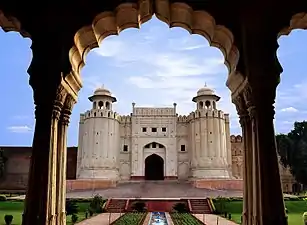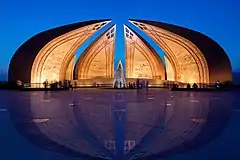Pakistani architecture
Pakistani architecture is intertwined with the architecture of the broader Indian subcontinent. With the beginning of the Indus civilization around the middle of the 3rd millennium BC,[1] for the first time in the area which encompasses today's Pakistan an advanced urban culture developed with large structural facilities, some of which survive to this day. This was followed by the Gandhara style of Buddhist architecture that borrowed elements from Ancient Greece. These remnants are visible in the Gandhara capital of Taxila.[2]
| Part of a series on the |
| Culture of Pakistan |
|---|
 |
| Traditions |
| Cuisine |
| Sport |
|
Indo-Islamic architecture emerged during the medieval period, which combined Indian and Islamic elements. The Mughal Empire ruled between the 16th and 18th centuries, and saw the rise of Mughal architecture, most prevalent in Lahore.
During the British Colonial period, European styles such as the Baroque, Gothic and Neoclassical became prevalent. The British, like the Mughals, built elaborate buildings to project their power. The Indo-Saracenic style, a fusion of British and Indo-Islamic elements also developed. After Independence, modern architectural styles like the International style became popular.
Indus Valley civilization

Archaeologists excavated numerous ancient cities, among them Mohenjo Daro, Harrappa and Kot Diji, which have a uniform, appropriate structure with broad roads as well as well thought out sanitary and drainage facilities. The majority of the discovered brick constructions are public buildings such as bath houses and workshops. Wood and loam served as construction materials. Large scale temples, such as those found in other ancient cities are missing. With the collapse of the Indus Valley civilization the architecture also suffered considerable damage.[3] View of Mohenjo-Daro towards the Great Bath.[4][5]
Unfortunately little is known about this civilization, often called Harappan, partly because it disappeared about 1700 BC for reasons unknown and because its language remains undeciphered; its existence was revealed only in the midst of the 19th century (your text says the 1920s), and excavations have been limited. Surviving evidence indicates a sophisticated civilization. Cities like Harappa and Mohenjo-Daro (the "City of the Dead") had populations of some 35,000, they were laid out according to a grid system. Inhabitants lived in windowless baked brick houses built around a central courtyard. These cities also had a citadel, where the public and religious buildings were located, large pools for ritual bathing, granaries for the storage of food, and a complex system of covered drains and sewers. The latter rivaled the engineering skill of the Romans some 2,000 years later.
Hindu, Buddhists and Jain architecture


Ancient and Classical period
With the rise of Buddhism outstanding architectural monuments were again developed, which have lasted into the present.[1] In addition, the Persian and Greek influence led to the development of the Greco-Buddhist style, starting from the 1st century AD. The high point of this era was reached with the culmination of the Gandhara style. Important remnants of Buddhist construction are stupas and other buildings with clearly recognizable Greek statues and style elements like support columns which, beside ruins from other epochs, are found in the Gandhara capital Taxila[6] in the extreme north of the Punjab. A particularly beautiful example of Buddhist architecture is the ruins of the Buddhist monastery Takht-i-Bahi in the northwest province.[7]
Middle Kingdoms
The Amb Temples and Sharada Peeth and Nagarparkar Jain Temples are other examples.
Indo-Islamic Architecture
The arrival of Islam in today's Pakistan - first in Sindh - during the 8th century CE meant a sudden end of Buddhist architecture. However, a smooth transition to predominantly pictureless Islamic architecture occurred.

The way early mosques were built with decorations oriented them strongly to the Arab style. The earliest example of a mosque from the days of infancy of Islam in South Asia is the Mihrablose mosque of Banbhore, from the year 727, the first Muslim place of worship in South Asia. Under the Delhi Sultan, the Persian-centralasiatic style ascended over Arab influences. The most important characteristic of this style is the Iwan, walled on three sides, with one end entirely open. Further characteristics are wide prayer halls, round domes with mosaics and geometrical samples and the use of painted tiles. The most important of the few completely discovered buildings of Persian style is the tomb of the Shah Rukn-i-Alam (built 1320 to 1324) in Multan.[9]
The Makli Necropolis at Thatta, which includes tombs of various rulers, noblemen and Sufi saints was built between the 14th and 18th centuries. It showcases a wide variety of architecture, including Indo-Islamic, Persian, Hindu and Rajput and Gujarati influences.[10][11] The Chaukhandi Tombs near Karachi are similar in style.[12]
Other examples include the Rohtas Fort built by Sher Shah Suri in the 16th century,[8] and the Tombs of the Talpur Mirs.
Mughal Architecture (15th–18th centuries CE)
Mughal architecture emerged in the medieval period during the reign of the Mughal Empire in the 15th to 17th centuries. Mughal buildings have a uniform pattern of structure and character, including large bulbous domes, slender minarets at the corners, massive halls, large vaulted gateways and delicate ornamentation, usually surrounded by gardens on all four sides.
The buildings are usually constructed out of red sandstone and white marble, and make use of decorative work such as pachin kari and jali-latticed screens.
Akbar and Jahangir (1556–1627)
The earliest example in Pakistan is the Lahore Fort, which had existed at least since the 11th century but was completely rebuilt by various Mughal Emperors.[13] The Tomb of Anarkali, Hiran Minar and Begum Shahi Mosque also date back to this period.
Shah Jahan (1628–1658)
The Tomb of Jahangir, the fourth Mughal Emperor, was completed in 1637 during the reign of his son and successor Shah Jahan. The Emperor had forbidden the construction of a dome over his tomb, and thus the roof is simple and free of any embellishments. It stands amidst a garden which also houses the Tomb of Nur Jahan, Tomb of Asif Khan and Akbari Sarai, the one of the most well-preserved caravanserais in Pakistan.[15]
Mughal architecture reached its zenith in the 17th century during the reign of Shah Jahan.[17][13] During this time, several additions were made to the Lahore Fort. Other masterpieces of this time include the Wazir Khan Mosque, Dai Anga Mosque, Tomb of Dai Anga, Shalimar Gardens and Shahi Hammam in Lahore.[18][14] The Shah Jahan Mosque in Thatta reflects a heavy Persian influence.[19]
Aurangzeb (1658–1707)
The Badshahi Mosque in Lahore was built during the reign of Aurangzeb in 1673. It is made out of red sandstone with three marble domes, very similar to the Jama Masjid of Delhi. It remains one of the largest mosques in the world.[16]
British Colonial architecture
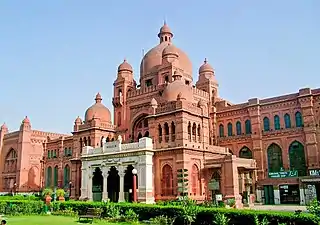
During the British Raj, European architectural styles such as baroque, gothic and neoclassical became more predominant. The Frere Hall, St. Patrick's Cathedral and Mereweather Clock Tower in Karachi, and neoclassical Montgomery Hall in Lahore are some examples.
A new style of architecture known as Indo-Saracenic revival style developed, from a mixture of European and Indo-Islamic components. Among the more prominent works are seen in the cities of Karachi (Mohatta Palace, Karachi Metropolitan Corporation Building), in Peshawar (Islamia College University) and Lahore (Lahore Museum, University of the Punjab and King Edward Medical University).
Post-Independence
After Independence, the architecture of Pakistan is a blend of historic Islamic and various modern styles.
This reflects itself, particularly in modern structures. In addition, buildings of monumental importance such as the Minar-e-Pakistan in Lahore or the mausoleum established with white marble known as Mazar-e-Quaid for the founder of the state expressed the self-confidence of the nascent state.
The city of Islamabad was designed by Greek architect Constantinos Apostolou Doxiadis and completed in 1966. The Faisal Mosque in Islamabad, one of the largest mosques in the world, is one of the best examples of modern Islamic architecture. It was designed by Vedat Dalokay and constructed between 1976 and 1986.
The National Monument in Islamabad, built in 2007 is in the shape of a blooming flower. The four main petals of the monument represent the four provinces of Balochistan, Khyber-Pakhtunkhwa, Punjab, and Sindh, while the three smaller petals represent the three territories of Gilgit-Baltistan, Azad Kashmir and the Tribal Areas.[lower-alpha 1]
Skyscrapers built in the international style are becoming more prevalent in the cities.
Gallery
Mughal
 Moti Masjid located within the Lahore Fort
Moti Masjid located within the Lahore Fort
 Mahabat Khan Mosque, Peshawar
Mahabat Khan Mosque, Peshawar Shah Jahan Mosque in Thatta
Shah Jahan Mosque in Thatta.jpg.webp) Oonchi Mosque in Lahore
Oonchi Mosque in Lahore A Mughal era monument - Chauburji in Lahore
A Mughal era monument - Chauburji in Lahore
Indo-Saracenic
 Mohatta Palace in Karachi
Mohatta Palace in Karachi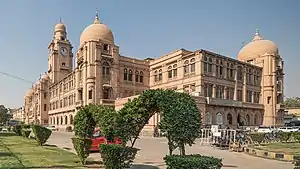
 University of the Punjab, Lahore
University of the Punjab, Lahore
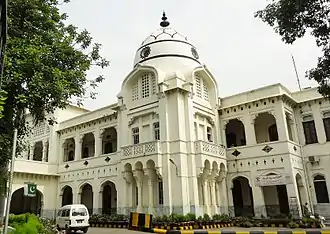 Patiala Block of King Edward Medical University, Lahore
Patiala Block of King Edward Medical University, Lahore Noor Mahal, Bahawalpur
Noor Mahal, Bahawalpur Karachi Chamber of Commerce Building
Karachi Chamber of Commerce Building Darbar Mahal, Bahawalpur
Darbar Mahal, Bahawalpur
 National Academy of Performing Arts, Karachi
National Academy of Performing Arts, Karachi Frere Hall, Karachi
Frere Hall, Karachi
Post-Independnce


_Clifton%252C_Karachi.jpg.webp) Teen Talwar, Karachi
Teen Talwar, Karachi Pakistan Monument, Islamabad
Pakistan Monument, Islamabad
World Heritage Sites
There are currently six sites in Pakistan listed under the UNESCO World Heritage:
- Archaeological Ruins at Moenjodaro
- Buddhist Ruins at Takht-i-Bahi and Neighbouring City Remains at Sahr-i-Bahlol
- Lahore Fort and Shalimar Gardens (Lahore)
- Historic Monuments of Thatta
- Rohtas Fort
- Taxila
See also
References
Notes
- Tribal Areas were merged into Khyber-Pakhtunkhwa in 2018.
Citations
- Guisepi, R.A. The Indus Valley And The Genesis Of South Asian Civilization Archived 2012-06-09 at WebCite. Retrieved on February 6, 2008
- Meister, M.W. (1997). Gandhara-Nagara Temples of the Salt Range and the Indus. Kala, the Journal of Indian Art History Congress. Vol 4 (1997-98), pp. 45-52.
- Meister, M.W. (1996). Temples Along the Indus Archived 2006-05-27 at the Wayback Machine. Expedition, the Magazine of the University of Pennsylvania Museum of Archaeology and Anthropology. Vol 38, Issue 3. pp. 41-54
- Centre, UNESCO World Heritage. "Archaeological Ruins at Moenjodaro". UNESCO World Heritage Centre. Retrieved 14 December 2018.
- Centre, UNESCO World Heritage. "Archaeological Site of Harappa". UNESCO World Heritage Centre. Retrieved 14 December 2018.
- Centre, UNESCO World Heritage. "Taxila". UNESCO World Heritage Centre. Retrieved 14 December 2018.
- Centre, UNESCO World Heritage. "Buddhist Ruins of Takht-i-Bahi and Neighbouring City Remains at Sahr-i-Bahlol". UNESCO World Heritage Centre. Retrieved 14 December 2018.
- Centre, UNESCO World Heritage. "Rohtas Fort". UNESCO World Heritage Centre. Retrieved 14 December 2018.
- Centre, UNESCO World Heritage. "Tomb of Shah Rukn-e-Alam". UNESCO World Heritage Centre. Archived from the original on 3 March 2018. Retrieved 14 December 2018.
- Centre, UNESCO World Heritage. "Historical Monuments at Makli, Thatta". UNESCO World Heritage Centre. Archived from the original on 1 February 2018. Retrieved 14 December 2018.
- "Makli Necropolis - Google Arts & Culture". Google Cultural Institute. Retrieved 14 December 2018.
- Centre, UNESCO World Heritage. "Chaukhandi Tombs, Karachi". UNESCO World Heritage Centre. Retrieved 16 December 2018.
- Centre, UNESCO World Heritage. "Fort and Shalamar Gardens in Lahore". UNESCO World Heritage Centre. Archived from the original on 6 November 2018. Retrieved 14 December 2018.
- Centre, UNESCO World Heritage. "Wazir Khan's Mosque, Lahore". UNESCO World Heritage Centre. Archived from the original on 2 August 2018. Retrieved 14 December 2018.
- Centre, UNESCO World Heritage. "Tombs of Jahangir, Asif Khan and Akbari Sarai, Lahore". UNESCO World Heritage Centre. Archived from the original on 1 February 2018. Retrieved 14 December 2018.
- Centre, UNESCO World Heritage. "Badshahi Mosque, Lahore". UNESCO World Heritage Centre. Retrieved 14 December 2018.
- Simon Ross Valentine. 'Islam and the Ahmadiyya Jama'at: History, Belief, Practice Hurst Publishers, 2008 ISBN 1850659168 p 63
- "Wazir Khan Mosque - Google Arts & Culture". Google Cultural Institute. Retrieved 14 December 2018.
- Centre, UNESCO World Heritage. "Shah Jahan Mosque, Thatta". UNESCO World Heritage Centre. Archived from the original on 3 October 2018. Retrieved 14 December 2018.
Further reading
- Mumtaz, Kamil Khan. Architecture in Pakistan. Singapore: Concept Media Pte Ltd, 1985.
- Maurizio, Taddei and De Marco, Giuseppe. Chronology of Temples in the Salt Range, Pakistan. South Asian Archaeology. Rome: Istituto Italiano per l'Africa e l'Oriente, 2000.
- Crossing Lines, Architecture in Early Islamic South Asia. Anthropology and Aesthetics 43 (2003)
- Malot and the Originality of the Punjab. Punjab Journal of Archaeology and History 1 (1997)
- Pattan Munara: Minar or Mandir?. Hari Smiriti: Studies in Art, Archaeology and Indology, Papers Presented in Memory of Dr. H. Sarkar, New Delhi: Kaveri Books, 2006.
External links
- ARTSEDGE Pakistan: The Gift of the Indus
- Pakistan's Salt Range Temples - A photographic review of Professor Michael W. Meister of the University of Pennsylvania.
- Architecture in Pakistan: A Historical Overview
- Islamic Architecture Pakistan
- Modernity and Tradition: Contemporary Architecture in Pakistan
- 100+1 Pakistani Architects And Their Own Houses - Amazon.com Accessed May 4, 2008
- Islamic Architecture in South Asia: Pakistan-India-Bangladesh
- The Architectural Heritage of Bahawalpur


